
Recently, while submitting to the fond attentions of a dental surgeon, I found myself musing idly, in an opiated haze, about the symbolic weight of teeth—musings disturbed only by the surgeon’s resolute yanking on the offending tooth, a yanking that came to me only distantly, as a not entirely unpleasant tugging, punctuated by the occasional squeak, reminiscent of the sound of a nail being pried out of a floorboard. Maybe it was the Novocain, but I found myself wondering if the widespread fear of dentists is at least in part a subconscious, perhaps even archetypal, fear of teeth, or if that’s just the perspective of someone whose dental history is written in anxiety and agony (and all the requisite drama-queen hysterics that go with them).
Certainly, the mouth, as the biggest breach in the body’s integrity, holds its own terrors (What’s this big hole in the middle of my face?! What if something falls out? What if something falls in?). Not for nothing has the face of mythic horror been a slavering maw (Alien), a toothy portal welcoming you to the afterworld (Jaws).
Teeth are scarier still. TV dramas such as CSI: Crime Scene Investigation and police-procedural fiction such as Patricia Cornwell’s novels about the forensic pathologist Kay Scarpetta have forged an ubreakable link, in the mass imagination, between teeth and death. In such narratives, teeth and dental records are often all that remain of the murdered; mute witnesses to their owner’s last moments, they testify to the victim’s identity and, ultimately, help finger the perp.
Teeth are by definition uncanny, the point at which the skull beneath the skin erupts through the body’s surface. It’s the Return of the Repressed (© Sigmund Freud; all rights reserved)—in this case, the death we do our best to forget while we’re busy living. A bony reminder that mortality is the subtext lurking just beneath the human comedy, teeth are the skeleton’s insistence that it, too, is ready for its close-up.
Okay, I’m over the top, here, but sometimes too much is just enough. Besides, who can top Freud, who took dental horror to Siegfried & Roy-like heights of rhetorical excess in his notorious theorization of the vagina dentata? Sure, Freud’s Victorian hysterics were all about sexual phobias, but his misogynistic horror story wouldn’t have packed the wallop it still does without the old Viennese devil’s canny use of the Dental Uncanny.
Poe, a Freudian avant la lettre, gave shape to primitive male fears of the Monstrous Feminine in his story “Berenice,” in which the narrator Egaeus, monomaniacally obsessed with his lover’s teeth, yanks them from her undead cadaver. His obsession is equal parts desire and horror:
The teeth!—the teeth!—they were here, and there, and everywhere, and visibly and palpably before me; long, narrow, and excessively white, with the pale lips writing about them, as in the very moment of their first terrible development.
(The critic Killis Campbell has suggested that Poe’s tale was inspired, in part, by a newspaper account of grave robbers who pried teeth out of corpses for use, presumably in the manufacture of false teeth, by local dentists, and Richard Zacks claims, in his eccentric compendium of weird facts, An Underground Education, that a “whole generation wore ‘Waterloo’ dentures made from teeth yanked from the corpses on the battlefield, and the practice continued as late as the Civil War, when thousands of teeth were stolen from bodies moldering at places like Bull Run and Gettysburg.” This ghoulish practice is echoed, in contemporary dentistry, by the use of “cadaveric pure aura mater sterilized under X-rays” to facilitate bone regeneration around dental implants.)
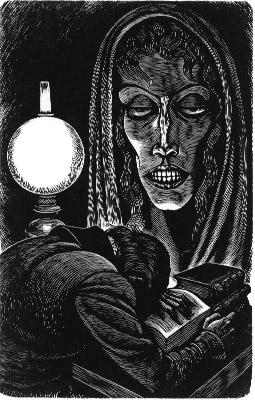
Illustration: Fritz Eichenberg. From Tales of Edgar Allen Poe (New York: Random House, 1944), author’s collection.
Freudians have extracted psychosexual subtexts from “Berenice,” reading Poe’s story as a literalization of male attempts to defang the vampiric feminine. Given the psychoanalytic interpretation of the mouth as a visual metaphor for the vagina (and vice versa), Berenice’s predatory “smile of peculiar meaning,” which so terrifies—and mesmerizes—the narrator, hints at the vagina’s unsettling (at least, to the patriarchy) ability to swallow all comers and spit them out limp, drained of their potency. By robbing Berenice of her gleaming teeth, the narrator enacts a sympathetic magic, “castrating” the Phallic Mother and repossessing the emblems of his lost virility. (In this reading, the teeth are phallic symbols. Isn’t everything?)
Still not convinced?
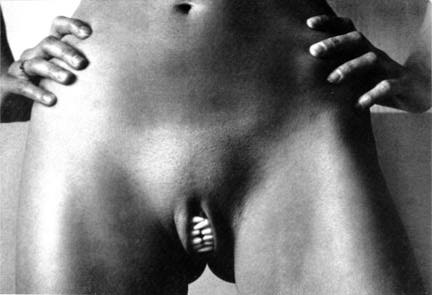
Exhibit A: Actual photo of a real, live vagina dentata, found on Rotten.com.
Exhibit B: Actual photo of an antique female mannequin with really scary teeth and a deeply creepy leer, found on eBay.
Case closed.
Personally, I’ve always viewed women’s nether regions as the Gates of Delirium. The mouth, however, is a bacterial killing field. My dental armamentarium is serious. (Remember that scene in The Matrix, where Neo says, “Guns, I need lots of guns,” and—wham-o, he’s in that celestial Wal-Mart, an infinite expanse of blinding white soundstage whose only displays are endless aisles of matte-black gun racks bristling with AK-47’s and Beretta 92FS pistols and HK MP5K’s and Micro Uzi SMG’s? Well, imagine all that hardware in white. And, uh, with fuzzy little FlexiSoft brushheads. And 3-D brushing action.) I’m fully loaded with the ubiquitous floss, although like all serious floss jocks I prefer Crest Glide® tape (“your weapon against plaque and gingivitis!”) to the standard-issue stuff civilians use. I’ve got the Glock 9 of electric toothbrushes, the Braun Oral-B Power Toothbrush with “ultra-speed oscillation,” a Waterpik® “dental water jet,” and that increasingly common prosthesis known as a night guard, the first line of defense against nocturnal tooth-grinding. Oh, and I’ve got this wicked little instrument my hygienist gave me, a gold-colored tool that looks like a miniature pharaoh’s crook, its curved end culminating in a rubber barb for cleaning those hard-to-floss crevasses.
Not that any of this heavy weaponry has availed me much in my never-ending battle against plaque, gum recession, and other fifth-columnist infiltrators of the body politic. It certainly didn’t forestall my Appointment with Destiny in the oral surgeon’s chair. It’s a genetic thing. Well, that, and growing up in the ’60s and ’70s, in that Lost World before glucose intolerance and vegan vigilance and organic anything, when “natural” was for those gap-toothed Oakies in WPA photographs and breakfast was a Pop Tart or a heaping bowl of Count Chocula and no sack lunch was complete without a Ding Dong or a Devil Dog and nothing slaked your cottonmouth thirst on those parched Southern California afternoons like a pitcher of Kool-Aid or, when I was out of short pants, an ice-cold Fresca.
All of which brings me, in the usual divagating way, back to the question of whether or not teeth are inherently fearsome things. Do they inspire fear and loathing for reasons buried deep in the cultural unconscious, or would I see them in a more innocuous light if I had the radiantly beamish grin of, say, Julia Roberts or the scary Steinway smile of motivational guru (and acromegalic giant?) Anthony Robbins.
On my back, with the good doctor attacking the recalcitrant molar with hammer and tongs, I thought about the brief fad, back in the glory days of industrial culture, for graphic images of extreme dental surgery, ripped from surgical textbooks and remixed in underground ‘zines. In that innocent time before Columbine, Abu Ghraib, and Rotten.com, nothing gave normals the fantods like in-your-face images of maxillofacial surgery. (Okay, the pre-MTV “music video” Despair, by the industrial band Surgical Penis Klinik, pretty much knocks the spots off even the grisliest dental-surgery photos, but needless to say, it remained a vanishingly obscure cult item, little known and rarely screened.) The fourth edition of the massive mail-order catalogue for the underground bookseller and publisher, Amok Books—one-stop shopping for style-conscious transgressives, in the late ’80s—includes a selection of pathology titles, featuring, for your delectation, the Color Atlas of Oral Cancers. Post-industrial artists such as Nine-Inch Nails have mined this vein in videos such as “Happiness in Slavery,” which features the late S/M performance artist Bob Flanagan strapped into a dentist’s chair from Hell and tortured by robotic drills with a mind of their own. (Oral horrors seem to be an ongoing obsession of NIN’s Trent Reznor, whose 2005 album was going to be called Let It Bleed but has been retitled With Teeth, at least according to rumor.) Marilyn Manson has been there, too, in his “Beautiful People” video, a KISS Army-meets-Joel-Peter Witkin fantasia in which the singer is fashionably accessorized by a gothic contraption that looks like the Grand Inquisitor’s idea of a dental retractor. (These days, Manson’s teeth are suitably scary all by themselves, now that The Artist Formerly Known as America’s Bogeyman has opted for a Weimar-era gloss on the Bond villain look.) The Swedish electronica artist Fingertwister has gotten in on the act, as well, in his song “The Dentist”, an ominous techno-dub track that incorporates snippets of operating-room dialogue (“got some blood, here”) and the high-pitched whine of a dentist’s drill, calculated to inspire a thrill of terror in any dentophobe.
There’s an inescapable viscerality to dental imagery that, er, sets the teeth on edge. The panic-attack feeling of being trapped in the chair, the helpless vulnerability of submitting to the dental dam and the tongue retractor, the inexorable descent of the whining drill, the rotten reek of burning decay: we’ve all been there. The gleaming sterility of the high-tech surgical instruments and the crisp professionalism of most dentists only serve to heighten our barely suppressed awareness of the medieval barbarity of the whole gory business. Which is exactly what makes that first prick of the needle, that first buzz of the drill, such a reality check. In a postmodern moment when our desensitized sensibilities demand ever more voltage from the atrocity exhibition that is pop culture (Fear Factor, Jackass, Extreme Makeover), and when embodied experience is growingly irrelevant as our “real” lives are lived increasingly on the other side of the terminal screen, the dentist’s drill is the short, sharp shock that reminds many of us that, for the moment at least, we still have bodies. In J.G. Ballard’s speculative novel Crash, the affectless narrator embraces the car crash that nearly killed him as a rejuvenating force, a bracing jolt that snaps him out of the media-induced numbness that had drained him of all spontaneous responses and genuine emotions. I’m reminded of a friend who once told me that he refused all anesthesia during dental operations for the simple reason that it’s a rare opportunity to experience the raw charge of real pain, a sensation we experience all too seldom, here in Prozac Nation. (He’s a better man than I, always wheedling that extra poke of Novocain, wussy that I am.)
Then, too, one of the (forgive pun; something about the subject seems to invite them) root causes of dentophobia may be the latent sadism of the whole situation: Like an S/M top, the masked, rubber-gloved dentist is both tormentor and Angel of Mercy, a dualism exploited by the almost unwatchable torture scene in John Schlesinger’s Marathon Man (1976)—the locus classicus for dentophobes—in which the Mengele-like Nazi doctor Christian Szell (Laurence Olivier) drills down to the nerve of one of Babe’s (Dustin Hoffman) teeth. In one hand, Szell holds sweet relief: clove oil, a topical anesthetic that banishes the brain-shriveling pain of seconds earlier. In the other, he holds the instrument of that agony: A dentist’s drill. There is something of the police-state interrogation cell, here, and of De Sade’s pleasure dungeon.

Dustin Hoffman, under the drill in Marathon Man.
As always, there’s a fine line between fear and fetish, and a Google search for “dental retractor” uncovers a clammy sub-subculture of that branch of S/M that inclines toward medical fetishes.
(Google results may be biased by the fact that the fetishists’ use of “retractor” differs from the accepted dental meaning of the word. To a dentist, a retractor is a small, pencil-shaped steel instrument, typically with a hook at the business end or, in the specific case of cheek retractors, an unintentionally hilarious contraption that looks like
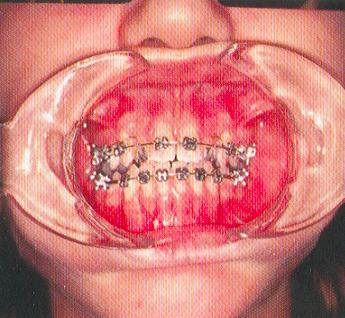
By contrast, when a fetishist talks about a retractor, he’s talking about something like
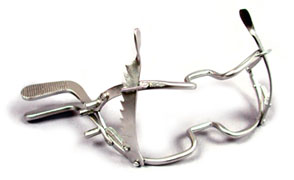
Dental fetishists rejoice in mock-medical paraphernalia, from double-ratchet retractors to dental forceps guaranteed to “force a mouth open to a maximum diameter of 2 1/8.”” (To what end, you ask? Discretion bids me leave the details to the reader’s fevered imagination.)
What is this? The psychosexual equivalent of the Stockholm Syndrome? Are those of us sentenced, by unlucky nature and unwise nurture, to long hours under the drill fated to act out nocturnal psychodramas in which we exorcize the traumas of the chair in pornographic narratives starring us, a willing co-star (or two), and the odd double-ratchet retractor? If so, I only hope that the nitrous oxide flows freely, and that I emerge from such transactions with all of my molars intact.
Go ahead: Rinse and spit.
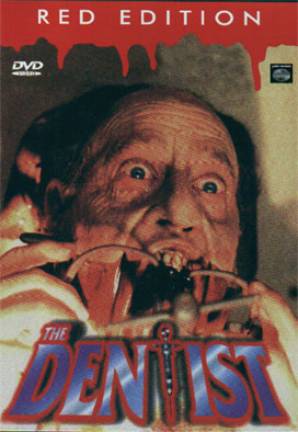

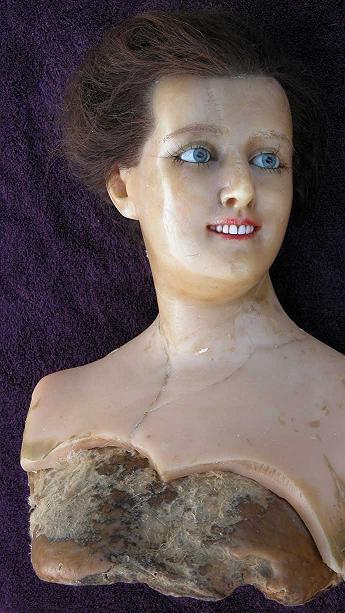
Carol Wald
To me, part of the strangeness of teeth is that they seem to be an excrescence of the skeleton, which is part of our interior space. To see our own skeletons is to see our own deaths–as it is to see anything that belongs inside our bodies. Jonathan Sawday has written a fascinating cultural history of anatomy and dissection that tackles this subject: The Body Emblazoned.
M. Dery
I made that point, I think, when I wrote >>And teeth are by definition uncanny—the point at which the skull beneath the skin erupts out of the body’s surface. It’s the return of the repressed, the skeleton’s insistence that it, too, is ready for its close-up.<< But you put it more pithily. The Sawday book sounds fascinating; I’ll run it down. Thanks for the reference! (I’ve just finished STIFF, which had its moments. Library shelves are fairly groaning with this sort of stuff, now, though when I wrote about the Mutter Museum, in THE PYROTECHNIC INSANITARIUM, cultcrit of gross-anatomy classes, pathology museums, and such like was all but unknown.)
Carol
Oops–yes, you did–I read your post too quickly. Sawday uses readings of art and literature to argue that the Renaissance “invention” of interiority was integrally linked to the explosion of interest in autopsies and dissection. I had my students read the introduction to the book as a part of their writing projects on the very bizarre “Body Worlds” exhibition, which is at the California Science Center in L.A. through January 23.
M. Dery
Fascinating. Students? Where? Mary Roach devotes a few passing paragraphs to the “Body Worlds” plastinator, Gunther von Hagens, in STIFF. Stunning stuff, though the neoclassical poses are a little cheesy. Have you read Barbara Maria Stafford? Her Zone book on the body might touch on the Renaissance interest in interiority, if memory serves. Have you seen pictures of the Baroque obstetric mannequins at La Specola, in Florence? Breathtaking. I’ve written on this, at http://www.gettingit.com/article/563.
Carol
(Speaking of students, the comment by “S. Peshali” smells like a class assignment.)
Have not read the Stafford book, or seen the obstetric mannequins, alas. I will see if I can find any images of the mannequins.
I read your post on gettingit.com–really interesting. I wonder if anyone has written about “Body Worlds” in terms of the techno-gothic mode you discuss? You comment that some of the poses of the plastinated corpses are “cheesy,” but to me, the point is that many of these poses echo centuries, maybe millenia, of art and philosophy about bodies, personhood, death, desire, gender, motherhood, and on and on. Von Hagens claims he was not aware of any of the artworks to which plastinated corpses of his corpus have been likened–such as, for instance, the image of the flayed man holding his skin (I think it’s from Vesalius, but I have to check). We can’t represent bodies unmediated by culture.
One thing I am wondering about after reading your techno-gothic post is how Von Hagens’ work fits into this cultural mode. Maybe, as with the “head-in-a-jar” running gag on “Futurama,” it’s their very denial of decay’s sensorium–their cleanliness, lack of odor–and in the surgically precise rationality of the dissective craft they display.
But back to teeth. There’s of course something feminizing and sexual in being on one’s back, mouth stretched wide, with a pointy instrument poking past the tongue. . . Then there’s the “bit” of satire’s passive-aggressive teeth-baring grimace . . . That’s it for me right now–got to run to catch the bus.
Carol
Correction: Not “bit” but “bite”.
Rebe
Oooh, Carol’s remark about the “bite” of satire reminds me of when you were all, “Dare I say ‘visceral’. . . ” when you were talking about cannibals and Martha Stewart. You intellectuals and your clever word-play!
Isaac
To quote Little Orphan Annie: “I think I’m gonna like it here!”
nick
I find it fascinating that what killed Freud was oral cancer: he had much of his jaw removed and reconstructed over the decades before his death, and yet still smoked 20 cigars a day. Oral fixation? Sometimes a cigar is just a cigar. But, still.
Also, T. S. Eliot comes to mind:
“Webster was much possessed by death
He saw the skull beneath the skin…”
And the Sawday book’s a very good read, though not quite apposite here. (I quoted from it, and Barbara Maria Stafford’s stuff, in my doctoral thesis on the birth of neurology in the 17th century, in relation to contemporary English literature.)
Another good book on the subject is Francis Barker’s ‘The Tremulous Private Body’, which is also about the relationship between anatomy and interiority/subjectivity in the world after Vesalius.
Anyway, back to teeth: as a Brit in the US, I get to hear all the usual gags about ‘bad teeth’, but when I hear about the horrors of braces and headgear regularly inflicted on American kids, I don’t feel so bad that my home country doesn’t promulgate dental perfection. (The London press covered Martin Amis’s £20,000 dental surgery with a mixture of amusement and perplexity…)
nick
One last point: dentistry has never traditionally been part of the ‘medical’ profession. Like surgery, it was the domain of the barber. There’s a long-standing distinction between invasive or tactile medicine in the hands of the barber-surgeon and the dentist, and one that takes place from a distance, through observation or ‘extracted’ analysis: the examination of blood, or urine, or excrement, taken from the body.
journal
Ok, now I’m creeped out
Some thoughts on Dentata Teeth are by definition uncanny, the point at which the skull beneath the skin erupts through the body’s surface. OK. Great. Now I can’t stop thinking about my teeth….
anaglyph
Hey, great posting.
Don’t forget the immensely disturbing scene in Polanski’s ‘The Tenant’ where Polanski’s character digs a tooth wrapped in cotton-wool out of his apartment wall. Got to be one of the most unsettling moments in cinema history.
Mikita
I love the blog – the design, style, layout, graphics, font, but mostly the prose.
Teeth are terrifying, really, when you come to think about it; are they really a part of *us*? Nothing bespeaks the grave so vividly as a mouth with missing teeth. Their absence signifies death, yet we can never get rid of them! It’s so creepy when human teeth are found in the excrement of bears and other wild animals.
There’s a character in Martin Amis’s novel “Dead Babies” who is obsessed with the horror of his own teeth.
Mikita
M. Dery
Whip-smart stuff, guys. My thoughts:
Carol:
“Von Hagens claims he was not aware of any of the artworks to which plastinated corpses of his corpus have been likened–such as, for instance, the image of the flayed man holding his skin (I think it’s from Vesalius, but I have to check). We can’t represent bodies unmediated by culture.”
I don’t believe his protestations for a minute. His _Homme Écorché_, as Baroque artists and anatomists called Vesalius’s flayed man (St. Bartholomew, one of my favorite martyrs, is likewise depicted jauntily carrying his skin over one shoulder, like Sinatra with his suitcoat, and anatomy studies often incorporated this biblical reference, as you may know). Anyway, Von Hagens’s to me obvious mimicry of classical sculpture and painting is of a piece with his interview comments to the effect that his work is both a popularization of scientific knowledge and his personal artistic expression. For my money, there’s something petit bourgeois about the need to mollify outraged bluenoses by invoking classical references that legitimate his plastinated corpses as Art with a capital “A.” Shades of Orlan’s middlebrow use of features ripped and remixed from classical works of art to add a whiff of legitimacy to her plastic surgery addiction-cum-performance art. Shades, too, of carnival midway banners that wrap the sensational in the mantle of scientific education and artistic edification.
Nick: Right, the T.S. Eliot line was what I had in mind when I wrote
>>Teeth are by definition uncanny, the point at which the skull beneath the skin erupts through the body’s surface. It’s the Return of the Repressed (© Sigmund Freud; all rights reserved)<<
Your thesis sounds fascinating. How did you relate neurology to lit? Can you synopsize it for the attention-challenged (me) in a _TV Guide_ blurblet?
Amis! Right! I should have mentioned that flap. If I expand this post into a published essay, I’ll definitely have to drag that into the fray. (I mean, “published” in the dead-tree sense of the world, because blogging is obviously publishing, although my chair informs that no tenure committee would accept blog posts as legitimate publications, which seems odd, given the academic fetish for “peer-reviewed” journals and “peer-reviewed” book manuscripts. What could be more “peer-reviewed” than a blog post?) By the way, while researching this post, I stumbled across a wonderfully arcane book, one of the very last hits in a gazillion-hit Amazon search for keyword “teeth” (I’m *so* glad I drilled all the way to the end of those results):
_British Teeth: An Excruciating Journey from the Dentist’s Chair to the Rotten Heart of a Nation
by William Leith, Michael Heath_
http://www.amazon.com/exec/obidos/tg/detail/-/0571208657/qid=1105912429/sr=1-1/ref=sr_1_1/002-5910206-4845640?v=glance&s=books
Due diligence:
From the Publisher
As a child, William Leith was educated in old, decaying buildings. During the holidays, his parents took him to see ruins, as a treat. Was it a sign of a nation growing old gracefully, or of something altogether more ominous, a nation whose culture was simply crumbling away? And then something happened. A tooth, which had been throbbing for a while, snapped. At the same time, the old house he’d just bought, began to crack too. During the course of his dental treatment, and the underpinning of his house, Leith cast his mind back over his personal history—his education, his diet, and particularly his dentistry—and thought about what it was to be British… William Leith interviews celebrities for THE GUARDIAN.
Product Description:
Bone loss, discoloration, abscesses, faulty fillings, collapsed bites, gum disease, microcracks, mercury leaks… The decline and fall of British teeth—and the British nation?
Oddly, this precipitated a conversation with my wife in which both of us confessed how disappointed we were that Bowie reportedly let Iman talk him into some orthodontic urban renewal, since we found his old, infamously imperfect teeth weirdly attractive. In his almost unbearably hilarious ’70s CREEM review, “Johnny Ray’s Better Whirlpool,” Lester Bangs dissed DB as a “pastyfaced snaggletoothed little jitterbug,” but I find that vulpine, incurving thing weirdly handsome. Is this the politicization of the smile—British snaggleteeth as a cool refusal to conform to the American standard in passive-aggressive friendliness, the inhumanly white, inhumanly straight rictus of imperial power? Maybe. Or maybe it’s just narcissism talking. Maybe I like DB’s old set because *my* teeth look like a picket fence after a tornado. On the other hand, there’s nothing attractive about Sean McGowan’s notoriously ghastly teeth. And Bangs also wrote a positively gothic description (at least 50% poetic license), in another ’70s CREEM article, of Keith Richard offhandedly picking a long, yellow sliver off a rotting tooth, in mid-sentence, and flicking it aside with fashionable junkie languor. Where were we? British teeth. Andrew Ross’s _Strange Weather: Culture, Science and Technology in the Age of Limits_ begins with a funny anecdote about how he, a Scotsman transplanted to the States, is shocked to learn that his American dentist expects *him* to take care of his own teeth. This, to Ross, is emblematic of our laissez-faire approach to socia services; in the UK, he maintains, your mouth is the state’s responsibility, via socialized healthcare. Which brings us back to the cultural politics of bad teeth. Design critic Rick POynor sent the following thoughts by e-mail:
“By playing up the Trent Reznor dimension, you perhaps avoid the deeper pain — the shame, actually — felt by the dentally challenged. America has led the way when it comes to the flawless smile as a beacon of personal virtue, and brandishing anything less feels like a sign not just of bad manners, but of bad inner essence. Insistent displays of dental perfection by cosmetically enhanced uber-people become yet another tool of subtle social oppression for those who will never measure up.
A wonderful piece of 1960s Dada tooth horror you might add to your gallery: Cal Schenkel’s cover for Zappa’s _Uncle Meat_.”
(If you don’t know Poynor’s criticism, BTW, grab his _Obey the Giant_ *immediately*. The man is blindingly brilliant on the subject of visual culture.
http://www.amazon.com/exec/obidos/ASIN/376436565X/qid=1105914478/sr=2-1/ref=pd_ka_b_2_1/002-5910206-4845640
And as long as I’m doing shout-outs, the “Mikita” who posted, just above, is Mikita Brottman, whose anthology _Car Crash Culture_ is a must for every Ballardian connoisseur of postmodern pathologies. (Full disclosure: I blurbed it. They slapped a line from my quote—“Keep one in the glove compartment, right beside your organ donor card”—on the cover.) Check it out at http://www.amazon.com/exec/obidos/ASIN/0312240384/ref=sib_rdr_dp/002-5910206-4845640
Mikita: There’s a creepy image of excreted teeth (exactly how arcane has this discussion gotten?) in _Hannibal_, Thomas Harris’s painfully lame sequel to his masterful _Silence of the Lambs_, Harris explains away Hannibal Lecter’s elemental evil as the post-traumatic result of childhood horrors—specifically, the fact that his little sister Mischa was killed and eaten by ravenous deserters in WWII. Here’s chapter and verse:
“He prayed so hard that he would see Mischa again, the prayer consumed his six-year-old mind, but it did not drown out the sound of the axe. His prayer to see her again did not go entirely unanswered—he did see a few of Mischa’s milk teeth in the reeking stool pit his captors used between the lodge where they slept and the barn where they kept the captive children who were their sustenance in 1944 after the Eastern Front collapsed…”
A memorable detail, but still…
yucky.
Interestingly, at http://hannibal.hannotations.com/hannibal3.html, a contributor to what appears to be a collaborative annotation of the Harris novels, _Dissecting Hannibal with a Blunt Little Tool_, writes:
“A couple of weeks ago my husband came to me and said he had run across something that might help explain Mischa’s teeth. He told me to read Edgar Allan Poe’s Berenice but refused to explain further. […] Teeth are a frequent theme in Harris’ books, from [serial killer Francis “The Tooth Fairy”] Dolarhyde’s to Mischa’s. And Harris may be pointing us toward Poe by setting parts of his stories in Baltimore. Very interesting idea.”
Which brings us full circle. What was it Foucault said about all texts being interconnected?
nick
“Your thesis sounds fascinating. How did you relate neurology to lit? Can you synopsize it for the attention-challenged (me) in a _TV Guide_ blurblet?”
Gawd. Elevator pitch: the seventeenth-century pioneers of brain science — the inventors of ‘the nerves’ as a concept — take their conceptual schemes and vocabulary from literary sources. These get put in the cultural mixer as ‘nervous medicine’ becomes popular, and are reabsorbed into literary culture, now carrying the kind of embodied baggage which has all sorts of implications for traditional models of literary, particularly poetic creation.
Watch your email.
Oh, William Leith: he was such a self-indulgent prick when he had his Observer column, during the late 90s era of self-indulgent prickish columns. But his book on teeth is actually not so bad.
Also, Ross’s Scotsman inspires nostalgia: it’s bloody hard to get on the list of an NHS dentist these days if you live in a big British city.
My gut feeling is that we’ve got competing narratives of self-empowerment: to a Brit, the American smile is indicative of Stepford conformity through artifice. To Americans, it’s a personal triumph over biological forces: a model of perfection that has been imposed at the cost of childhood ignominy, and is maintained through Whitestrip-assisted struggle.
It’s manifest in different ways: the US-British dynamic is dental; when the French enter the equation (for both Brits and Americans) it’s all about hairy armpits and body odour.
Cancergiggles
It was only when I reached the tender age of 47 that I discovered, whilst translating for a friend, the utter joy of watching a complex tooth extraction.